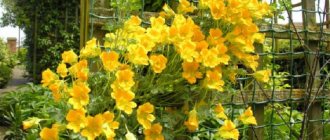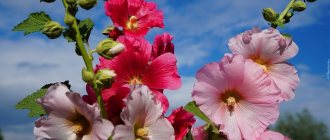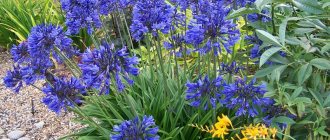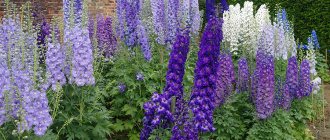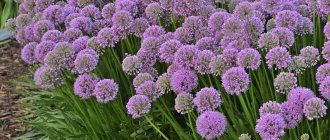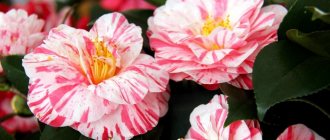In a garden, or park, alley, or just near a country house you can see bright, attractive nasturtium flowers.
This prevalence of the plant is largely explained by the fact that the greenery of the plant, like the flower itself, is characterized by a rich color.
Varieties and varieties of nasturtium
There are more than 45 types of nasturtium.
The plant comes from warm regions of America, where it is mainly perennial. Our frosty winters do not leave a single chance for it to survive the winter, so in our country nasturtium is often grown as an annual. The following cultivated species are popular: Canary - is a vine with stems up to 3.5 m, where bright yellow flowers, up to 20 mm in diameter, resembling a small bird in shape, stand out against the background of light green five- or seven-part leaves. Blooms from June to December.
Canary nasturtium
Bolshaya is a shrub with large shield-shaped leaves, with long and thin stems, sometimes growing up to 250 cm. Flowering begins in July and continues until November. There are many varieties of this species.
Large nasturtium
The following are popular:
- "King Theodore"
- "Peach Melba";
- "Salmon Baby";
- "Ladybug".
Small – the diameter of the flowers is only about 30 mm, the stems are short – up to 0.35 m. The most common varieties are “Black corduroy” and “Cherry rose”.
Small nasturtium
Shield -bearing plant is a plant with 4-meter shoots, with scarlet or red flowers appearing in June. Mainly one variety of this ground covering flower is grown – “Lucifer”.
Shield nasturtium
Cultivated - a species obtained by crossing a large and a shield-bearing one. There are 2 subspecies: creeping and dwarf. The most commonly sold seeds are the following varieties:
- "Moonlight";
- Golden Globe;
- "Glemming Mahogany."
Cultural nasturtium
Characteristic
Nasturtium in a flowerbed (photos of flowers are presented in the article to familiarize yourself with the garden plant) can be cultivated in the central regions, the Moscow region and central Russia. The plant is a herbaceous flowering crop whose homeland is considered to be South America. In nature, there are approximately 90 varieties of flowers that thrive in mid-latitudes.
Nasturtium is in great demand among gardeners because it has elegant and long-lasting flowering, and is also characterized by beneficial properties and excellent taste.
The flower came to Russia from the Netherlands. Here it is called capuchin. The culture consists of perennial and annual varieties, subshrubs and vines. The flowers, when open, have an unusual shape. At the same time, they have a rich smell. Mostly yellow and red inflorescences are found.
The culture is mainly presented in the form of a vine with a powerful stem. The foliage is lobed. Flowers are double or semi-double and consist of 5 petals. However, their number may be greater depending on the type of plant.
The frost resistance of the crop is not very high. Upon completion of the flowering stage, a fruit is formed on the flower, which consists of 3 wrinkled and kidney-shaped lobes. The seeds are round and kidney-shaped. There is a wide range of different plant varieties available in horticulture. Moreover, some varieties of the crop are edible. The following types of nasturtium are considered widespread and most popular.
Nasturtium tuberous
It is presented as a creeping, herbaceous and annual crop that has branched and dense shoots. The latter look like a ball because they are strongly intertwined with each other. The diameter of the ball of shoots can reach approximately 1.5 m. The root system grows embossed tubers during the development of the flower. Inflorescences are red-orange with a gradient transition.
Large nasturtium
It is a tall variety, the height of which can be approximately 2.5 m. The plant has large and quite bright flowers, the diameter of which can reach up to 6 cm.
Large nasturtium is also represented by low and dense subshrubs, which are covered with salmon, pinkish or peach inflorescences.
Small nasturtium
It is a compact variety of crop that has small flowers. Their diameter does not exceed 3 cm. Subshrubs are considered quite dense and elastic. They are capable of reaching approximately 35 cm in height. Shield-like foliage densely covers the plant.
Foreign nasturtium
The variety is represented by a climbing and elongated vine, on which yellow inflorescences appear. This type of crop is suitable for forming a blooming and thick green wall, since it tightly entwines vertical supports.
Nasturtium climbing
It is an annual vine that can fill a huge area in 12 months.
Nasturtium in a flowerbed can be climbing.
Suitable for landscaping verandas, balconies and horizontal fences.
Planting and caring for nasturtium
A flower such as nasturtium, the cultivation and care of which does not cause much trouble for flower growers, is a good decoration for the site, as confirmed by numerous photos taken by summer residents and designers. Let's consider all the stages of its cultivation.
Before planting nasturtium, you should choose the right place. Strong drafts and shade are contraindicated for her. Soil characteristics also play an important role. Regardless of the type and variety, nasturtium loves slightly acidic, fertile, light soil and good drainage. On heavy clay soils, the roots rot and the plant dies. Watering this plant should be treated with caution. Capuchins are uncomfortable in excessively wet soil, but at the moment when sprouts appear and their active development begins, watering is necessary. If you follow all the rules of care, nasturtium will bloom 45 days after germination.
Be careful and follow the nasturtium watering regime
When nasturtium blooms, the number of waterings is reduced; water only during prolonged drought. They also remove fading flowers, normalize the amount of ovary, get rid of weeds, and mulch the soil around the bushes. If you plan to obtain your own seeds, then the large ovary should be left to mature. In the south, seeds that fall to the ground germinate in the spring, but experienced gardeners do not recommend growing nasturtium in this way. Seeds must be collected in the fall and sown in the ground in the spring according to all the rules. If nasturtium is still blooming profusely before the onset of frost, then given that it cannot overwinter in our latitudes, it is placed in flowerpots and brought indoors. It will look good on a bright but cool window.
Planting a flower
The main thing during the landing process is to choose the right place. If you carefully fulfill this condition, your flower, or the whole alley, will be lush, with the maximum possible flowering.
Remember that this flower does not tolerate drafts or shade. The soil for planting must be moist and highly fertile. Well-drained, slightly acidic, light soil is suitable for any variety of nasturtium.
Note! Avoid overwatering the plant, especially during active flowering. As a result of abundant watering, the flower may be very small, and the leaves will be lush.
Most often, the plant is planted at the end of May. If you planted the seeds, then expect the flower to start growing and blooming a little later.
Nutrients for nasturtium
Fertilizers and fertilizing are also necessary for the normal development of nasturtium. True, it is not worth fertilizing the beds intended for it with fresh manure - the plant does not tolerate it. The soil is mixed with rotted manure, but if it is not available, then the store sells special preparations in the form of superphosphate and potassium sulfate. They add very little - per 1 sq. m teaspoon.
Fertilize regularly
Before the plant begins to bloom, experts advise fertilizing with potassium-phosphorus fertilizers to induce abundant flowering. Sometimes nasturtium leaves turn yellow, not only on the lower ones, but also on the upper ones. One of the reasons may be a deficiency of minerals. The situation will be corrected by adding azofoska.
Attention: do not get carried away with fertilizing containing a lot of nitrogen fertilizers, otherwise the nasturtium will not bloom at all or very weakly.
Disease and pest control
Although nasturtium repels whiteflies, aphids, Colorado potato beetles and cabbageweed, it is also associated with diseases. Affects capuchins:
- bacterial wilt, when the lower leaves first disappear and then the entire plant disappears;
- gray rot, which manifests itself as dry gray-brown spots on leaves and shoots;
- rust, indicated by small black and brown spots that turn into bumps;
- mosaic - manifests itself as a mosaic pattern on the leaves;
- ring spot, when the leaves are covered with small dots surrounded by a red-brown border.
Gray rot on nasturtium leaves.
The affected parts of the plant are removed and burned, and the rest is treated with chemical or bacteriological preparations.
Propagation of nasturtium
Nasturtium, both annual and perennial, is mainly propagated by seeds and seedlings, but sometimes gardeners, when growing new varieties, follow a more complex path - they root young cuttings.
Before planting the seeds, they are placed for a very short time in water heated to 40 degrees C, then soaked for 24 hours. Sowed only in well-warmed, dug and leveled open ground. Make holes in the garden bed at intervals of 25 cm and throw 2 seeds into them. If frequent cold snaps are observed even at the end of spring, then the bed for planting capuchins is watered with well-heated water, and after sowing the seeds, it is also covered with film.
Nasturtium seeds
Nasturtium grown through seedlings will bloom much faster. It is better to plant the planting material in peat cups so as not to affect the delicate roots when transplanting. Sprouts at room temperature usually appear after a week and a half. From this moment on, the best conditions for their normal development are a temperature of 18 degrees and plenty of light. Replanting to a permanent location is permissible after stable heat has been established.
Terry, expensive varieties of nasturtium require more attention; planting and caring for it are also appropriate. It is propagated by cuttings previously placed in water or wet sand. When the roots appear, they are transferred to separate peat cups filled with loose, fertile soil. Subsequently, the shoots are planted in a garden bed or in a pot.
Nasturtium seedlings
Peculiarities
Nasturtium has a number of both positive and negative qualities. Therefore, when growing a flower crop, you need to familiarize yourself with all its nuances in advance so that you can grow a healthy and strong plant.
| Advantages | Flaws |
| The flower can easily grow in one season. | Flowers appearing on the bush are not suitable for cutting. |
| The culture is characterized by spicy foliage, which is edible. Therefore, it is permissible to include it in salads to obtain a piquant flavor. | To make a salad, the green mass can be cut only when several leaves have formed on the branch. |
| The plant is able to protect other flower crops, since it can prevent the appearance of insect pests in the garden plot. | Only young leaves will be tasty. Large foliage has a list of scents. |
| The flower does not require specific care and can grow normally in dry soil. | For abundant flowering, the plant requires sunlight and warmth. |
| The plant does not require frequent feeding and watering. |
Nasturtium grown in a flowerbed will not cause much trouble to growers. The flower, photographs of which are presented in the article, requires timely watering, fertilizing and regular pruning.
Nasturtium in combination with other plants in landscape design
An easy way to change the design of your garden is to grow nasturtiums. Flower growers consider it one of the best crops for decorating an estate, and often photos of bright landscape fragments confirm that they are right. The main thing is to choose a place that matches the specific type of this plant. Borders and mixborders are created from bush capuchins. They look great in large tubs and hanging flowerpots. The place around trees and along walls is most suitable for large nasturtiums.
Nasturtium in landscape design
Climbing fragrant nasturtium is an excellent material for hedges, decorating gazebos and balconies. White, purple climbing capuchins are very good in combination with the bright flowers of double petunias in the foreground or other low-growing flowers.
Tip: plant a colorful capuchin in a bed with cabbage, and then the white capuchin will not destroy the crop, and use the leaves and green seeds of the capuchin to make salads.
Petunia is not only a beautiful, but also a useful plant. It is a decoration for the site, a repeller for many pests, and an exotic addition to dishes.
Collection of medicinal raw materials
The preparation of material for medicinal purposes is carried out during the flowering period, and the seeds are collected at the moment of ripening. Leaves, stems and flowers are dried naturally in a shady, well-ventilated place. The fruits can be dried in dryers, and only then removed to prepare tinctures and decoctions.
Fresh nasturtium leaves are rich in ascorbic acid and will add piquancy to any dish. The taste of the leaves is sourish-sharp, and the flowers have a more peppery, spicy taste. The seeds of the plant can be used instead of pepper if they are ground.
Nasturtium contains chemicals such as:
- Tropeolin;
- Essential oil;
- Mustard glycosides;
- Carotene;
- B vitamins;
- Phytoncides;
- Iodine;
- Potassium;
- Phosphorus.
These substances have important effects on the body.
The use of nasturtium promotes:
- Improving immunity;
- Strengthening metabolism;
- Removing toxins from the body;
- Increased performance;
- Normalization of the nervous system;
- And much more.
It seems that this list can be continued endlessly.
But, like any medicine, nasturtium should be used in moderate doses, and you should also make sure that this plant does not cause allergic reactions in the body before using it.
In folk medicine you will find many recipes using nasturtium to treat a wide variety of diseases.
Nasturtium is a truly valuable plant; it will decorate your garden plot or balcony and will delight you with fragrant inflorescences all season long. It requires almost no special care. You will always have a source of vitamins and minerals at hand for your home medicine cabinet.
Medicinal properties and harm
The richness of the vitamin composition of capuchin determines its medicinal properties:
- bactericidal – for the treatment of various types of inflammatory conditions;
- anti-scorbutic - to combat vitamin deficiencies;
- expectorants - to relieve cough;
- diuretics - to eliminate swelling.
The beneficial properties and contraindications of nasturtium are associated with the individual reaction of the body. To check it, you first need to try chewing one leaf and make sure there is no allergy. Nasturtium should not be consumed by people with acute stages of inflammation of the stomach and intestines. The plant is not recommended for children, pregnant and lactating women.
Nasturtium medicinal properties

